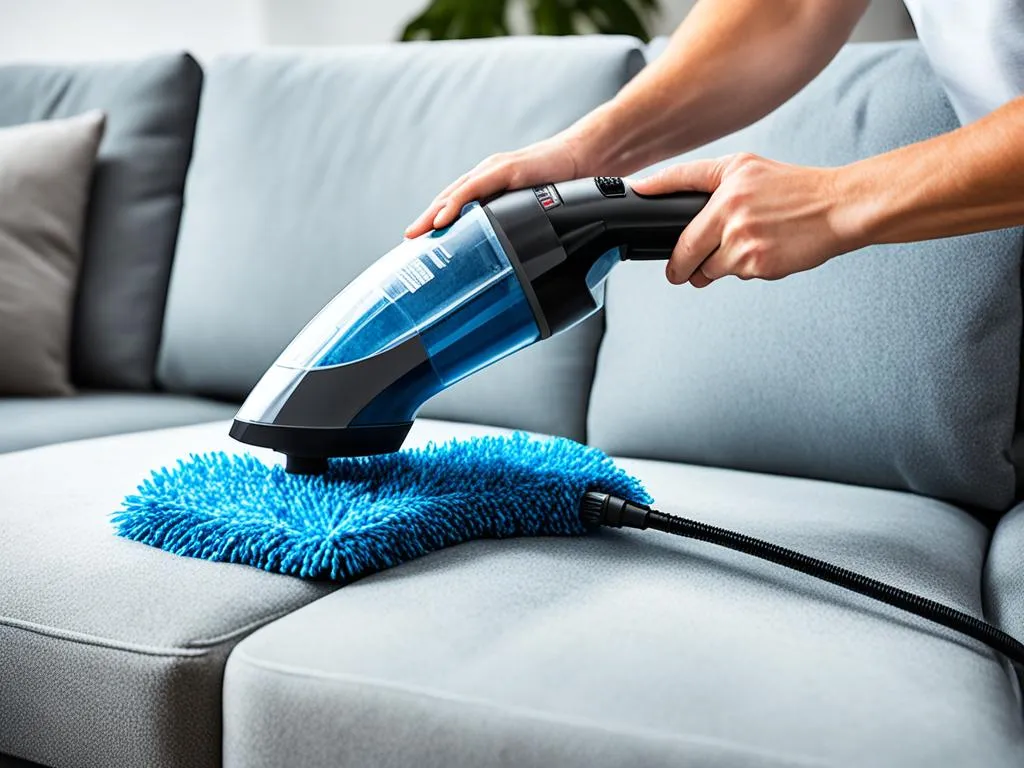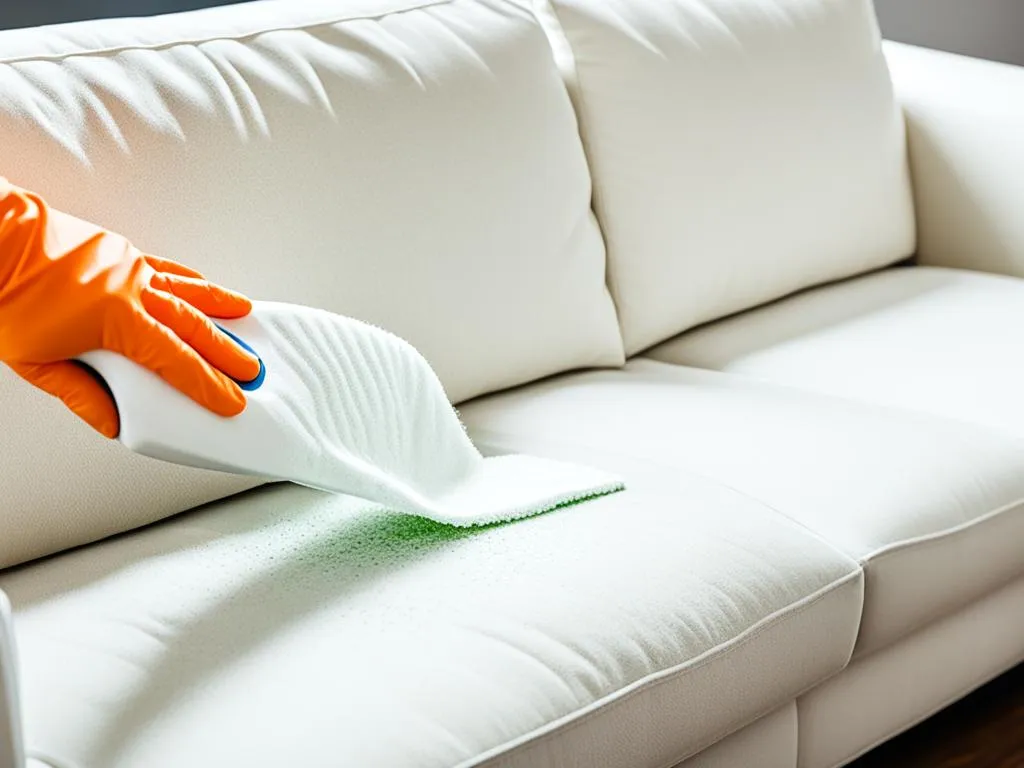
“The goal of cleaning is more than just making things look good. It’s about creating happiness in our surroundings,” Marie Kondo says. This includes your polyester couch, a key piece in your home. It’s important to take care of it to keep its good looks and extend its lifespan.
A polyester couch is both tough and easy to look after. This makes it great for busy homes. But to keep it looking and feeling great, you need to know how to clean it properly. Choosing the right upholstery cleaner can make all the difference, keeping your couch in top shape.
Whether it’s daily dust or spills, cleaning your polyester couch right is key. It starts with the cleaning instructions on the tag. Learning which cleaner to use and how to apply it helps protect the fabric. This keeps your couch looking great in your space.
Key Takeaways
- Identify your couch’s cleaning code (W, S, SW, X) before beginning the process.
- Select the right upholstery cleaner based on the manufacturer’s tag.
- Regular vacuuming is essential for removing surface debris and preparing for deep cleaning.
- Gently apply the cleaner and use a soft-bristled brush post-cleaning to fluff up the fabric.
- Always test cleaners on inconspicuous areas to prevent fabric damage.
- Professional cleaning services may be required depending on the specific care tag code.
- Reviewing care labels prior to purchase can prevent future maintenance challenges.

Understanding Your Polyester Couch’s Cleaning Codes
Before cleaning your polyester couch, check its care instructions. Knowing whether to spot clean or deep clean starts with finding the right cleaning codes. This prevents damage to the fabric.
Deciphering Symbols and Codes on Upholstery Tags
Look under your couch’s cushions for a tag with cleaning codes. These codes tell you how to take care of your couch. “W” means to use water-based cleaners for gentle cleaning. “S” means a solvent-based cleaner is needed for your upholstery.
Choosing the Appropriate Cleaning Solution
To clean a “W” code polyester couch, mix warm water with mild detergent. For an “S” code, find a special polyester solvent. Picking the right cleaner ensures your couch won’t get damaged. It keeps your furniture looking good.
Recognizing the Do’s and Don’ts Based on Code Categories
Following cleaning codes protects your couch from damage. Avoid harsh chemicals like bleach and acetone unless allowed. With “X” codes, DIY cleaning won’t work—professional cleaning is essential for these cases.
Keep these tips in mind to clean your couch safely and effectively. If unsure, hiring professionals is always best for your couch.
Initial Cleaning Steps to Prepare Your Couch
Getting ready to deep clean your durable polyester fabric couch starts with the right steps. Use your vacuum to remove loose dirt, crumbs, and other particles. Don’t forget to use the vacuum’s attachments to clean the hard-to-reach spots.
After vacuuming, take a dry brush and gently shake the fabric. This action helps get rid of tough particles. It also helps the polyester to look fresh again. Check the couch for pests too, to be safe.
Then, look for the cleaning code on your couch. It’s often found under the cushions or along the seams. The labels—W, S, SW, or X—tell you how to clean your couch correctly. Always test a cleaning solution on a small area first.
It’s crucial to clean in a space with good air flow. And, remember to wear gloves for safety when using cleaners.
How To Clean A Polyester Couch
Want to clean a polyester couch? Start by creating a gentle cleaning solution. Just mix a little mild detergent with warm water in your spray bottle. For an extra boost, add a bit of white vinegar. This works great on upholstery with a “W” cleaning code.

First, try it on a small, hidden spot to ensure safety. The goal is to lightly dampen, not soak the area. Use a soft-bristle brush or sponge to rub the solution in with circular moves. Make sure the fabric is evenly treated without getting too wet.
After scrubbing softly, grab a clean, dry cloth to remove any left residue. Letting your couch air dry naturally is crucial. It’s best to wait patiently rather than trying to rush the drying. This avoids mold and keeps water marks away, keeping your couch looking and feeling fresh.
- Dilute mild detergent in warm water in a spray bottle.
- Conduct a hidden spot test to guarantee fabric safety.
- Gently clean with a sponge or soft brush, avoiding saturation.
- Wipe with a clean cloth and allow to air dry for a fresh finish.
| Material | Cleaning Agent | Tool | Drying Method |
|---|---|---|---|
| Polyester Couch | Mild Detergent + Warm Water (Optional: White Vinegar) | Soft-bristle Brush/Sponge | Air Dry |
Addressing Common Stains and Spills
Facing stubborn stains on your polyester couch can seem hard. But, with the proper steps, you can remove stains well. This keeps your couch looking great. From pet accidents to wine spills, knowing how to quickly handle these problems helps. This way, your pet friendly sofa avoids serious damage. Here’s what to do when you spot those tough stains and spills.
Dealing with Stubborn Stains Using Mild Detergents and Vinegar
For hard stubborn stains, a mix of mild dish soap and distilled vinegar is effective. This mix is great for spot treatment. It works on many spills, including pet and food stains. If something spills, gently blot the area. Don’t rub it to prevent pushing the stain deeper.

Tackling Pet Accidents and Polyester Couch Care
If you have pets, taking care of your polyester couch is crucial. Act fast when pet accidents happen. This stops the spill from setting and becoming a bigger pet stain removal job. For removable cushion covers, always check the washing instructions. Many can be easily cleaned in the machine.
| Type of Stain | Spot Treatment | Preventative Measures |
|---|---|---|
| Pet Urine | Blot with vinegar solution, then apply enzyme cleaner if necessary | Regularly clean with a vacuum cleaner equipped for pet hair |
| Food and Beverage | Gently apply soapy water, then vinegar solution; blot dry | Keep couch covers and throws handy to minimize direct spills |
| Mud and Dirt | Allow to dry, vacuum up the debris, then lightly dab with a damp cloth | Use a stain repellent spray suited for polyester couch care |
Good polyester couch care is key to keeping your pet friendly sofa in top shape. Regular cleaning is easy and fast stain treatment prevents big problems. Now, you can relax in a clean and comfy space!
Regular Maintenance for Upholstery Longevity
Caring for your polyester couch is key to its longevity and your enjoyment. A daily cleaning routine is not just for looks. It also improves your home’s overall wellness.
Cleaning spills right away is essential. But, adding regular vacuuming to your cleaning habits helps keep dirt away. This way, grime won’t settle in your cozy spaces.
Vacuuming Techniques for Daily Upkeep
A vacuum cleaner is a must-have against daily dirt. Focus on the crevices where crumbs and pet hair gather. Use the upholstery attachment of your vacuum to clean thoroughly. Don’t miss the under cushions, especially if you can remove them.
For a welcoming couch, sweep it with a microfiber cloth. This keeps your furniture ready for guests or a quiet night in.
The Role of Professional Cleaning in Couch Maintenance
At times, your couch needs more than a simple clean. This is when professional polyester couch cleaning comes to the rescue. Pros know how to deal with deep dirt using special products. They handle upholstery maintenance tasks that aren’t easy to do regularly.
Having professional cleaning help occasionally gets rid of tough stains and dirt. This leaves your couch fresh and inviting, just like when you first got it.
| Upholstery Type | Recommended Cleaning Frequency | Professional Deep Clean |
|---|---|---|
| Polyester Couch | Weekly vacuuming, Daily dusting with microfiber cloth | Every 12-24 months |
| Leather Sofa | Bi-weekly vacuuming, Use special leather cleaner as needed | Every 18-24 months |
| Vintage Settee | Monthly vacuuming, Gentle brushing for dust | Consult with a professional; varies based on condition |
In conclusion, a polyester couch is more than just decor. It reflects your home’s care. Regular vacuuming and hiring professionals as needed keep your couch beautiful. And it thrives, making your space wonderful.
Conclusion
Making sure your polyester couch stays fresh isn’t just about the quick clean-ups. It means paying attention to care labels. This helps you choose the right cleaner. Knowing how to clean a polyester couch well can prevent damage from becoming permanent.
Vacuuming often and cleaning spots right away helps keep your couch looking good. But sometimes, you might need more help. This is when professional cleaners come in. They offer deep cleaning without hurting the fabric, something that’s hard to do by yourself.
Caring for your couch well means it will last longer and stay comfortable. Using the best cleaning practices keeps your polyester couch looking great. It makes sure your couch remains a cozy, stylish part of your home for years.
FAQ
What are the cleaning codes on my polyester couch, and what do they mean?
Your polyester couch has cleaning codes for the right cleaning methods. “W” means use water-based solutions. “S” is for solvent-based cleaners. “SW” means both types are okay. “X” means only a professional should clean it. These codes help avoid fabric damage.
How can I decipher the symbols and codes on my upholstery tags?
Look at the tag on your couch to find the cleaning code. This code tells you how to clean it. It could be water-based solutions, solvents, both, or by professionals.
What should I do before applying any cleaning solution to my polyester couch?
First, vacuum the couch with a vacuum cleaner to remove dust and dirt. Use a dry brush to get more dirt off. Then, test the cleaning solution in a hidden spot to make sure it’s safe.
Can I use a spray bottle to apply the cleaning solution to my polyester couch?
Yes, applying your cleaning solution with a spray bottle works great. It evenly spreads the solution without soaking the fabric too much. Just be sure to mix the solution according to your couch’s cleaning code.
How should I address stubborn stains on my polyester couch?
Mix mild dish soap with distilled vinegar for tough stains. Put it on the stain and dab gently. Don’t rub it. Always do a spot test first.
Are polyester couches considered pet-friendly sofas, and how should I clean pet accidents?
Polyester couches are durable and easy to clean, making them great for pets. Clean pet accidents by dabbing the spot right away with a clean cloth. Use a mild detergent and vinegar mix to clean. Wash removable covers in the machine if it’s allowed.
How often should I vacuum my polyester couch, and what techniques should I use?
Vacuum your couch once a week or when needed to keep it clean. Use the upholstery attachment to reach everywhere. Wipe it down with a microfiber cloth every day to keep dust away.
What’s the role of professional cleaning in maintaining my polyester couch, and how often should it be done?
Getting your couch professionally cleaned is important for deep cleaning and hygiene. Do it every 1-2 years, or more often if necessary. This is especially true for couches marked with an “X” code.



